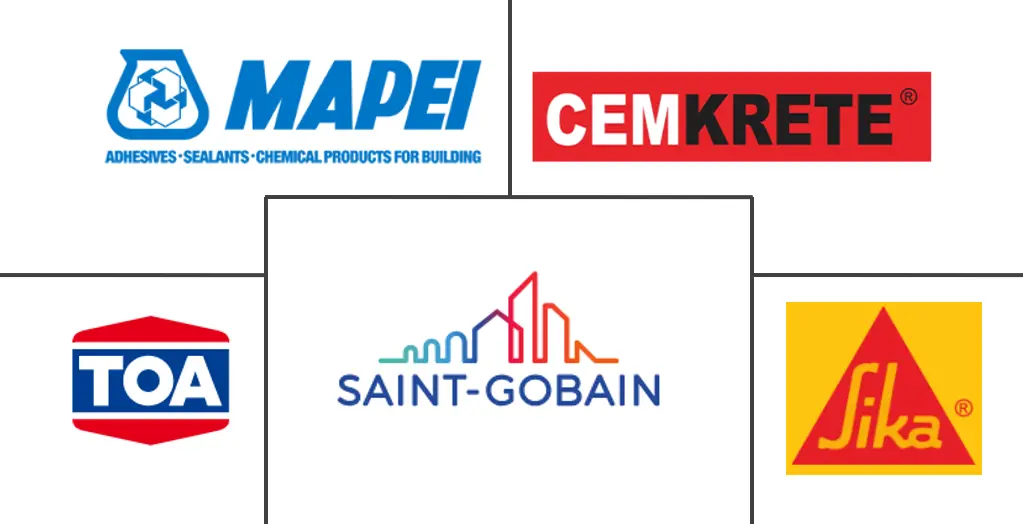Thailand Construction Chemicals Market Size and Share
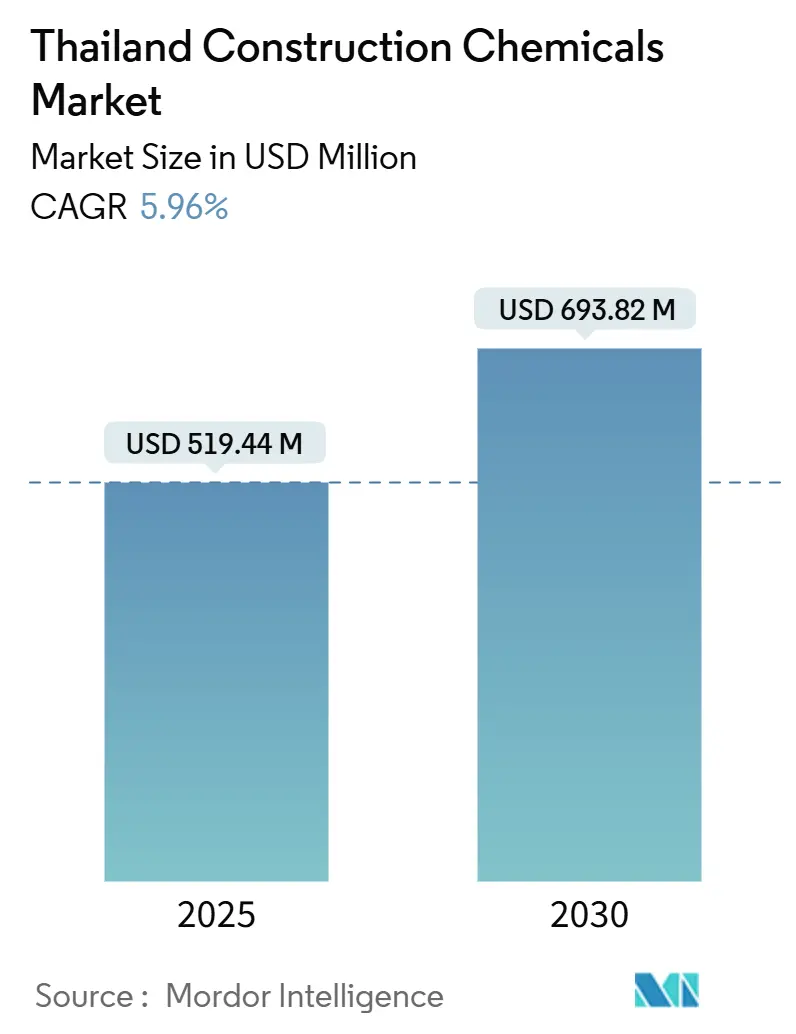
Thailand Construction Chemicals Market Analysis by Mordor Intelligence
The Thailand Construction Chemicals Market size is estimated at USD 519.44 million in 2025, and is expected to reach USD 693.82 million by 2030, at a CAGR of 5.96% during the forecast period (2025-2030). Resilient urban housing demand, a nationwide pivot toward eco-certified products, and the accelerated maintenance cycle for 1990s-era assets combine to widen the opportunity set for suppliers that can meet Thai Industrial Standards Institute (TISI) specifications. In parallel, contractors are shifting toward pre-packaged, user-friendly compounds to mitigate skilled-labor shortages and improve on-site productivity. Price pressure from volatile petrochemical feedstocks persists, yet established vendors leverage local backward integration and Green Label credentials to defend margins while expanding project pipelines in Bangkok, Chonburi, and Rayong.
Key Report Takeaways
- By product category, waterproofing solutions led with 41.97% revenue share in 2025, while surface treatment chemicals are projected to expand at a 6.77% CAGR through 2030.
- By end-user sector, the industrial and institutional segment accounted for 37.48% of the Thailand construction chemicals market share in 2025; infrastructure is advancing at a 6.68% CAGR to 2030.
Thailand Construction Chemicals Market Trends and Insights
Driver Impact Analysis
| Drivers | (~) % Impact on CAGR Forecast | Geographic Relevance | Impact Timeline |
|---|---|---|---|
| Robust investment in infrastructure projects | +2.1% | National, highest in EEC and Greater Bangkok | Medium term (2-4 years) |
| Urbanization-led housing demand | +1.8% | Bangkok Metropolitan Area, secondary cities | Long term (≥ 4 years) |
| Sustainability push for low-VOC/green chemicals | +1.2% | Nationwide, early uptake in Bangkok and Chiang Mai | Short term (≤ 2 years) |
| Rising demand for high-performance admixtures in megaprojects | +0.9% | EEC, Bangkok corridors, industrial zones | Medium term (2-4 years) |
| Ageing infrastructure repair cycle | +0.7% | National, priority in Bangkok | Long term (≥ 4 years) |
| Source: Mordor Intelligence | |||
Robust investment in infrastructure projects drives market expansion
Megaprojects such as the Suvarnabhumi Airport expansion, MRT Blue Line extension, and multibillion-baht flood-mitigation schemes require high-performance admixtures capable of resisting chloride ingress, sulfate attack, and cyclic wet–dry conditions in Thailand’s humid tropics. Established suppliers that already hold TISI certificates enjoy an early-mover edge because imported niche materials face longer approval timelines. Contractors favor one-stop solution providers that bundle design assistance with on-site application support, which raises the switching cost and locks in specification-driven demand. Long-term concession models in rail and toll-road assets further incentivize owners to select premium chemical systems that minimize life-cycle maintenance outlays.
Urbanization-led housing demand accelerates residential chemical consumption
Greater Bangkok’s condominium stock continues to grow, fueled by inward migration and mass-transit connectivity projects that open new residential nodes. Developers specify solvent-free sealants, flexible tile adhesives, and pre-mixed screeds to achieve faster floor turnover times without compromising indoor-air benchmarks. TOA Paint’s collaboration with Property Perfect, Supalai, and Lalin Property illustrates how local manufacturers embed low-VOC coatings and high-reflectance exterior paints in large-scale master-planned communities[1]TOA Group, “Company History and Development,” toagroup.com. Condominium towers also incorporate elastomeric façade coatings and fast-curing polyurethane waterproofers to withstand monsoon exposure at height. Away from Bangkok, secondary cities such as Chiang Mai adopt similar product suites as provincial governments invest in urban infrastructure corridors. Retail chains extend distribution coverage into these markets, sharpening price competition but deepening overall Thailand construction chemicals market penetration.
Sustainability push for low-VOC and green chemicals transforms product mix
Thailand’s tally of 601 LEED-registered projects and 448 certified buildings validates a structural shift toward environmental labeling in procurement[2]United Nations Development Programme, “Climate-Proofing Infrastructure Investment in Thailand,” undp.org. The Eco Building Code in 2025 caps permissible solvent content in coatings and mandates documentation of embodied carbon for concrete admixtures. Suppliers respond by launching bio-based resins and waterborne primers whose volatile organic compound readings register below 10 g/L, far under the 50 g/L ceiling. TOA’s Organic Care interior range, certified under the USDA BioPreferred scheme, typifies this pivot with plant-derived binders and ultra-low odor formulations. Green-label compliance now influences bidding scores in state-financed buildings, translating ecological features into direct revenue wins. Over time, developers expect green chemicals to realize rental-rate premiums, reinforcing the Thailand construction chemicals market trajectory toward higher-value sustainable solutions.
High-performance admixtures meet megaproject engineering demands
Deep-foundation pile caps, underground stations, and precast bridge segments require slump retention of more than or equal to 120 minutes and compressive strength > 65 MPa at 28 days. Superplasticizers based on polycarboxylate ether (PCE) chemistry deliver the necessary workability without elevating water-cement ratios, while shrinkage-reducing agents mitigate cracking in hot-weather pours common to Bangkok’s 35 °C job-site temperatures. Local producer Double Saturn runs 3.6 million liters per month of liquid admixture capacity to fulfill these specifications. In tunnel liners, silica fume and colloidal silica densifiers enhance abrasion resistance, extending maintenance cycles beyond 50 years. Such specialty blends secure repeat orders across the Thailand construction chemicals market whenever contractors replicate design templates for successive mass-transit or logistics projects.
Restraint Impact Analysis
| Restraints | (~) % Impact on CAGR Forecast | Geographic Relevance | Impact Timeline |
|---|---|---|---|
| Feedstock price volatility | -1.4% | Nationwide, Map Ta Phut supply chain | Short term (≤ 2 years) |
| Construction-labor shortages | -0.8% | Bangkok and EEC zones | Medium term (2-4 years) |
| Fiscal-budget disbursement delays | -0.5% | Nationwide public projects | Short term (≤ 2 years) |
| Source: Mordor Intelligence | |||
Feedstock price volatility pressures manufacturer margins
Petrochemical inputs originating from Map Ta Phut Industrial Estate track Brent crude swings closely. An abrupt 35% surge in styrene and butadiene costs during 2024 shaved 180–240 basis points off gross margins for epoxy-flooring formulators. PTT Global Chemical’s 15-year ethane-import contracts starting 2029 should dampen cost spikes and offer smoother resin price curve. In the interim, manufacturers hedge exposure using forward contracts and by reformulating toward filler-rich recipes without compromising TISI tensile-adhesion thresholds. Cost-optimized packs carve out share in the lower-tier residential channel, while high-margin eco-lines still command premiums in the institutional segment of the Thailand construction chemicals market.
Construction labor shortages constrain application and installation
A 12% skilled-worker gap yields schedule overruns for 65% of active projects, postponing order conversion for waterproof membranes and epoxy self-leveling floors. Applicator scarcity is most acute in Bangkok, where foreign labor policies limit migrant inflows. Suppliers now offer pre-proportioned grouts and cartridge-based injection resins that cut mixing complexity and reduce on-site headcount. Technical academies operated jointly by vendors and the Federation of Thai Industries certify more than 4,000 applicators annually, yet demand still exceeds supply during the peak wet-season construction window. Reliability-focused owners therefore favor products with wider open-time and forgiving cure profiles, ensuring performance continuity despite variable crew proficiency.
Segment Analysis
By Product: Waterproofing Solutions Remain Cornerstone of Project Specifications
Waterproofing compounds contributed 41.97% to the Thailand construction chemicals market in 2025, mirroring chronic monsoon exposure and heightened flood-defense budgets. Surface treatments on the other hand are expanding at a CAGR of 6.77% through 2030. Liquid-applied polyurethane systems dominate podium decks, whereas crystalline admixture slurries gain traction for below-grade slabs with congested reinforcement. Growth persists as rail depots, data centers, and hospital basements intensify water-ingress control tolerances.
Lithium-silicate densifiers seal capillary pores in polished warehouse slabs servicing e-commerce logistics operators. Hydrophobic silane-siloxane impregnations protect precast bridge parapets that confront chloride-laden coastal spray on the Pattaya–Rayong corridor. As the country bids to extend design life of concrete roadways to 40 years, curing compounds with moisture-retention efficiency above 90% become standard in Department of Highways specifications.
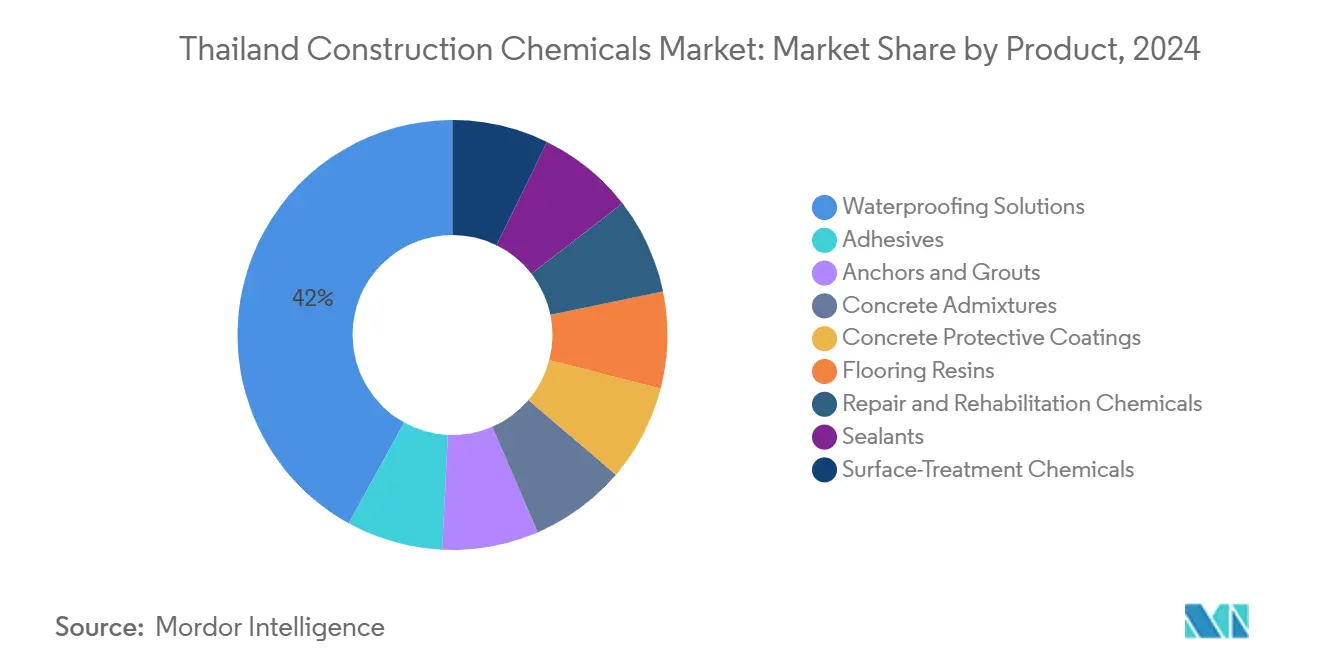
Note: Segment shares of all individual segments available upon report purchase
By End-User: Industrial and Institutional Segment Anchors Revenue Base
Industrial and institutional projects contributed 37.48% of Thailand construction chemicals market revenue in 2025. Infrastructure registers the highest 6.68% CAGR inside the Thailand construction chemicals market through 2030, reflecting the synchronized rollout of rail, road, and port megaprojects. Institutional sub-segments such as hospitals and universities embrace Green Label products to meet LEED Gold targets. Demand steadiness stems from multi-year campus expansion plans financed by public-private partnerships, locking in recurring orders for paint, sealants, and waterproofing systems.
Public procurement norms reward bidders offering factory-pre-blended dry-mix mortars that cut on-site labor by 20%, aligning with the sector’s shortage of skilled applicators. Life-cycle cost analysis embedded in tender scoring prompts asset owners to favor materials guaranteeing 50-year durability, shifting volume into higher-grade admixtures and coatings.
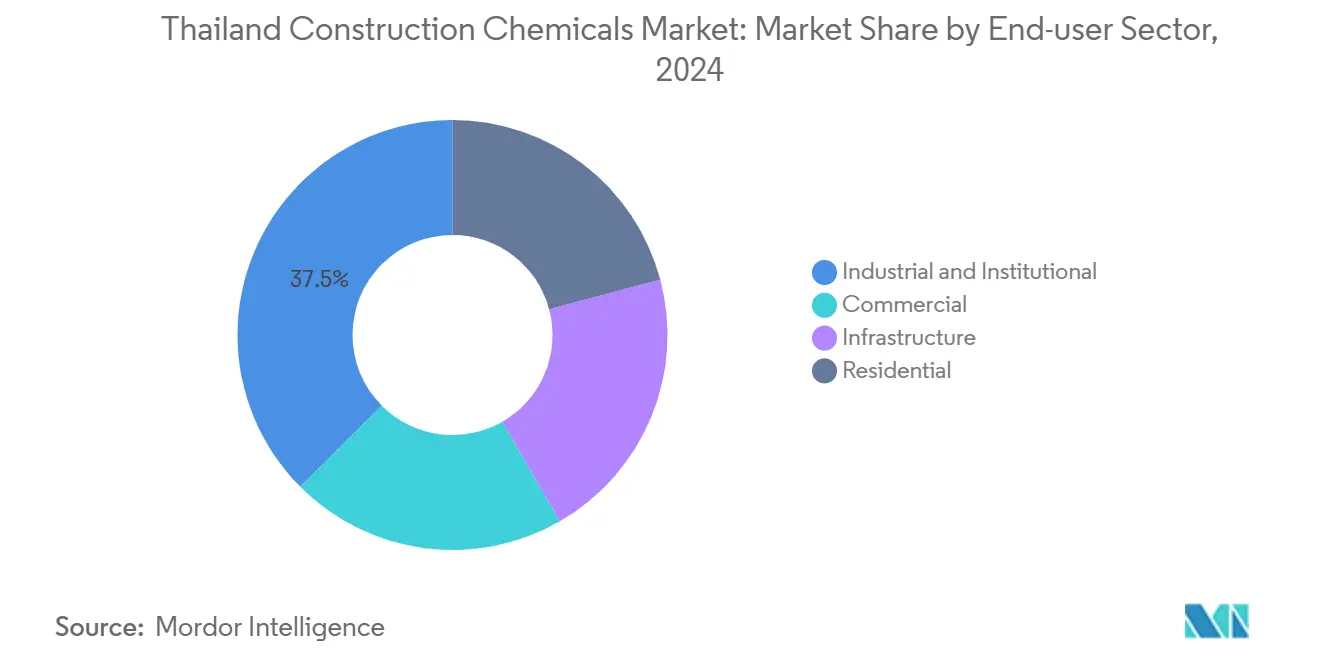
Note: Segment shares of all individual segments available upon report purchase
Geography Analysis
The Bangkok Metropolitan Area accounts for a major slice of Thailand construction chemicals market size, underpinned by dense mass-transit extensions, high-rise residential clusters, and premium commercial projects. Stronger purchasing power among industrial EPC contractors in these zones drives adoption of US ASTM-aligned admixtures and coatings.
Northern hubs such as Chiang Mai and Lampang open fresh pockets of demand as logistics corridors link the region to Lao PDR and Myanmar. Government incentives shift selected assembly plants to these provinces, bringing in orders for flooring resins and anti-static paints. In the south, tourism-led infrastructure including airports and marinas stimulates waterproofing membrane and protective-coating uptake, aided by salt-air exposure that accelerates corrosion.
Thailand’s geographic centrality within ASEAN facilitates cross-border supply to Cambodia and Laos, allowing domestic producers to run larger batch sizes and amortize fixed costs. Conversely, concentration of feedstock production at Map Ta Phut presents a single-point risk during typhoon disruptions, prompting distributors to hold safety stock in inland depots. Collectively, these patterns shape the Thailand construction chemicals market whose regional dynamics hinge on the interplay between megaproject localization and supply-chain resilience.
Competitive Landscape
The sector remains moderately fragmented. Saint-Gobain, RPM International, MAPEI, Sika, and Henkel leverage global researrch and development and technical-service teams to secure metro, airport, and refinery specifications. Strategic moves continue: Saint-Gobain’s 2025 acquisition of Fosroc broadens its admixture and waterproofing platform in Thailand; Sika’s earlier MBCC deal folds BASF-origin products into an expanded distributorship footprint. Local niche players exploit TISI certification barriers to introduce bio-based sealants and high-solids epoxies that meet Green Label thresholds.
Thailand Construction Chemicals Industry Leaders
-
Saint-Gobain
-
Sika AG
-
CEMKRETE CO.,LTD.
-
MAPEI S.p.A.
-
TOA Paint (Thailand) Public Company Limited
- *Disclaimer: Major Players sorted in no particular order
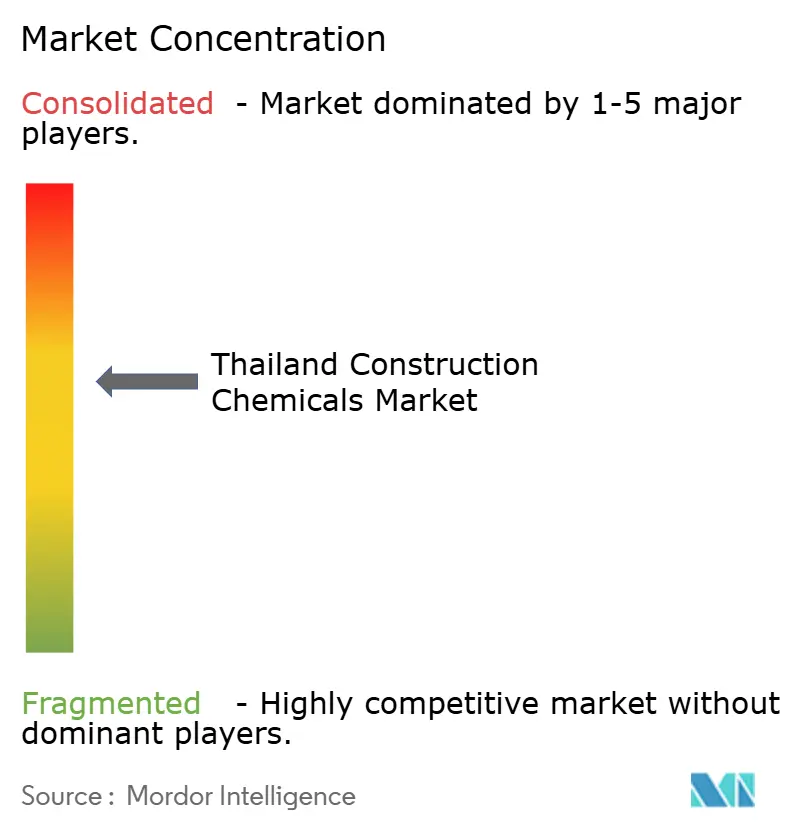
Recent Industry Developments
- February 2025: Saint-Gobain finalized the acquisition of Fosroc, gaining a full range of admixture, waterproofing, and repair products targeted at Southeast Asian infrastructure expansions.
- February 2023: Sika completed the purchase of MBCC Group, integrating admixtures, grouts, and sealants into its Thai portfolio to accelerate project wins across metro and port upgrades.
Thailand Construction Chemicals Market Report Scope
Commercial, Industrial and Institutional, Infrastructure, Residential are covered as segments by End Use Sector. Adhesives, Anchors and Grouts, Concrete Admixtures, Concrete Protective Coatings, Flooring Resins, Repair and Rehabilitation Chemicals, Sealants, Surface Treatment Chemicals, Waterproofing Solutions are covered as segments by Product.| Adhesives | Hot-Melt |
| Reactive | |
| Solvent-borne | |
| Water-borne | |
| Anchors and Grouts | Cementitious Fixing |
| Resin Fixing | |
| Concrete Admixtures | Accelerator |
| Air-Entraining | |
| Super-plasticizer | |
| Retarder | |
| Shrinkage-Reducer | |
| Viscosity-Modifier | |
| Plasticizer | |
| Other Types | |
| Concrete Protective Coatings | Acrylic |
| Alkyd | |
| Epoxy | |
| Polyurethane | |
| Other Resins | |
| Flooring Resins | Acrylic |
| Epoxy | |
| Polyaspartic | |
| Polyurethane | |
| Other Resins | |
| Repair and Rehabilitation Chemicals | Fiber-Wrapping Systems |
| Injection Grouting | |
| Micro-concrete Mortars | |
| Modified Mortars | |
| Rebar Protectors | |
| Sealants | Acrylic |
| Epoxy | |
| Polyurethane | |
| Silicone | |
| Other Resins | |
| Surface-Treatment Chemicals | Curing Compounds |
| Mold-Release Agents | |
| Other Types | |
| Waterproofing Solutions | Chemicals |
| Membranes |
| Commercial |
| Industrial and Institutional |
| Infrastructure |
| Residential |
| By Product | Adhesives | Hot-Melt |
| Reactive | ||
| Solvent-borne | ||
| Water-borne | ||
| Anchors and Grouts | Cementitious Fixing | |
| Resin Fixing | ||
| Concrete Admixtures | Accelerator | |
| Air-Entraining | ||
| Super-plasticizer | ||
| Retarder | ||
| Shrinkage-Reducer | ||
| Viscosity-Modifier | ||
| Plasticizer | ||
| Other Types | ||
| Concrete Protective Coatings | Acrylic | |
| Alkyd | ||
| Epoxy | ||
| Polyurethane | ||
| Other Resins | ||
| Flooring Resins | Acrylic | |
| Epoxy | ||
| Polyaspartic | ||
| Polyurethane | ||
| Other Resins | ||
| Repair and Rehabilitation Chemicals | Fiber-Wrapping Systems | |
| Injection Grouting | ||
| Micro-concrete Mortars | ||
| Modified Mortars | ||
| Rebar Protectors | ||
| Sealants | Acrylic | |
| Epoxy | ||
| Polyurethane | ||
| Silicone | ||
| Other Resins | ||
| Surface-Treatment Chemicals | Curing Compounds | |
| Mold-Release Agents | ||
| Other Types | ||
| Waterproofing Solutions | Chemicals | |
| Membranes | ||
| By End-User Sector | Commercial | |
| Industrial and Institutional | ||
| Infrastructure | ||
| Residential | ||
Market Definition
- END-USE SECTOR - Construction chemicals consumed in the construction sectors such as commercial, residential, industrial, institutional, and infrastructure are considered under the scope of the study.
- PRODUCT/APPLICATION - Under the scope of the study, the consumption of construction chemical products such as concrete admixtures, repair and rehabilitation chemicals, flooring resins, waterproofing solutions, anchors and grouts, adhesives and sealants, and surface treatment chemicals is considered.
| Keyword | Definition |
|---|---|
| Accelerator | Accelerators are admixtures used to fasten the setting time of concrete by increasing the initial rate and speeding up the chemical reaction between cement and the mixing water. These are used to harden and increase the strength of concrete quickly. |
| Acrylic | This synthetic resin is a derivative of acrylic acid. It forms a smooth surface and is mainly used for various indoor applications. The material can also be used for outdoor applications with a special formulation. |
| Adhesives | Adhesives are bonding agents used to join materials by gluing. Adhesives can be used in construction for many applications, such as carpet laying, ceramic tiles, countertop lamination, etc. |
| Air Entraining Admixture | Air-entraining admixtures are used to improve the performance and durability of concrete. Once added, they create uniformly distributed small air bubbles to impart enhanced properties to the fresh and hardened concrete. |
| Alkyd | Alkyds are used in solvent-based paints such as construction and automotive paints, traffic paints, flooring resins, protective coatings for concrete, etc. Alkyd resins are formed by the reaction of an oil (fatty acid), a polyunsaturated alcohol (Polyol), and a polyunsaturated acid or anhydride. |
| Anchors and Grouts | Anchors and grouts are construction chemicals that stabilize and improve the strength and durability of foundations and structures like buildings, bridges, dams, etc. |
| Cementitious Fixing | Cementitious fixing is a process in which a cement-based grout is pumped under pressure to fill forms, voids, and cracks. It can be used in several settings, including bridges, marine applications, dams, and rock anchors. |
| Commercial Construction | Commercial construction comprises new construction of warehouses, malls, shops, offices, hotels, restaurants, cinemas, theatres, etc. |
| Concrete Admixtures | Concrete admixtures comprise water reducers, air entrainers, retarders, accelerators, superplasticizers, etc., added to concrete before or during mixing to modify its properties. |
| Concrete Protective Coatings | To provide specific protection, such as anti-carbonation or chemical resistance, a film-forming protective coat can be applied on the surface. Depending on the applications, different resins like epoxy, polyurethane, and acrylic can be used for concrete protective coatings. |
| Curing Compounds | Curing compounds are used to cure the surface of concrete structures, including columns, beams, slabs, and others. These curing compounds keep the moisture inside the concrete to give maximum strength and durability. |
| Epoxy | Epoxy is known for its strong adhesive qualities, making it a versatile product in many industries. It resists heat and chemical applications, making it an ideal product for anyone needing a stronghold under pressure. It is widely used in adhesives, electrical and electronics, paints, etc. |
| Fiber Wrapping Systems | Fiber Wrapping Systems are a part of construction repair and rehabilitation chemicals. It involves the strengthening of existing structures by wrapping structural members like beams and columns with glass or carbon fiber sheets. |
| Flooring Resins | Flooring resins are synthetic materials applied to floors to enhance their appearance, increase their resistance to wear and tear or provide protection from chemicals, moisture, and stains. Depending on the desired properties and the specific application, flooring resins are available in distinct types, such as epoxy, polyurethane, and acrylic. |
| High-Range Water Reducer (Super Plasticizer) | High-range water reducers are a type of concrete admixture that provides enhanced and improved properties when added to concrete. These are also called superplasticizers and are used to decrease the water-to-cement ratio in concrete. |
| Hot Melt Adhesives | Hot-melt adhesives are thermoplastic bonding materials applied as melts that achieve a solid state and resultant strength on cooling. They are commonly used for packaging, coatings, sanitary products, and tapes. |
| Industrial and Institutional Construction | Industrial and institutional construction includes new construction of hospitals, schools, manufacturing units, energy and power plants, etc. |
| Infrastructure Construction | Infrastructure construction includes new construction of railways, roads, seaways, airports, bridges, highways, etc. |
| Injection Grouting | The process of injecting grout into open joints, cracks, voids, or honeycombs in concrete or masonry structural members is known as injection grouting. It offers several benefits, such as strengthening a structure and preventing water infiltration. |
| Liquid-Applied Waterproofing Membranes | Liquid-Applied membrane is a monolithic, fully bonded, liquid-based coating suitable for many waterproofing applications. The coating cures to form a rubber-like elastomeric waterproof membrane and may be applied over many substrates, including asphalt, bitumen, and concrete. |
| Micro-concrete Mortars | Micro-concrete mortar is made up of cement, water-based resin, additives, mineral pigments, and polymers and can be applied on both horizontal and vertical surfaces. It can be used to refurbish residential complexes, commercial spaces, etc. |
| Modified Mortars | Modified Mortars include Portland cement and sand along with latex/polymer additives. The additives increase adhesion, strength, and shock resistance while also reducing water absorption. |
| Mold Release Agents | Mold release agents are sprayed or coated on the surface of molds to prevent a substrate from bonding to a molding surface. Several types of mold release agents, including silicone, lubricant, wax, fluorocarbons, and others, are used based on the type of substrates, including metals, steel, wood, rubber, plastic, and others. |
| Polyaspartic | Polyaspartic is a subset of polyurea. Polyaspartic floor coatings are typically two-part systems that consist of a resin and a catalyst to ease the curing process. It offers high durability and can withstand harsh environments. |
| Polyurethane | Polyurethane is a plastic material that exists in various forms. It can be tailored to be either rigid or flexible and is the material of choice for a broad range of end-user applications, such as adhesives, coatings, building insulation, etc. |
| Reactive Adhesives | A reactive adhesive is made of monomers that react in the adhesive curing process and do not evaporate from the film during use. Instead, these volatile components become chemically incorporated into the adhesive. |
| Rebar Protectors | In concrete structures, rebar is one of the important components, and its deterioration due to corrosion is a major issue that affects the safety, durability, and life span of buildings and structures. For this reason, rebar protectors are used to protect against degrading effects, especially in infrastructure and industrial construction. |
| Repair and Rehabilitation Chemicals | Repair and Rehabilitation Chemicals include repair mortars, injection grouting materials, fiber wrapping systems, micro-concrete mortars, etc., used to repair and restore existing buildings and structures. |
| Residential Construction | Residential construction involves constructing new houses or spaces like condominiums, villas, and landed homes. |
| Resin Fixing | The process of using resins like epoxy and polyurethane for grouting applications is called resin fixing. Resin fixing offers several advantages, such as high compressive and tensile strength, negligible shrinkage, and greater chemical resistance compared to cementitious fixing. |
| Retarder | Retarders are admixtures used to slow down the setting time of concrete. These are usually added with a dosage rate of around 0.2% -0.6% by weight of cement. These admixtures slow down hydration or lower the rate at which water penetrates the cement particles by making concrete workable for a long time. |
| Sealants | A sealant is a viscous material that has little or no flow qualities, which causes it to remain on surfaces where they are applied. Sealants can also be thinner, enabling penetration to a certain substance through capillary action. |
| Sheet Waterproofing Membranes | Sheet membrane systems are reliable and durable thermoplastic waterproofing solutions that are used for waterproofing applications even in the most demanding below-ground structures, including those exposed to highly aggressive ground conditions and stress. |
| Shrinkage Reducing Admixture | Shrinkage-reducing admixtures are used to reduce concrete shrinkage, whether from drying or self-desiccation. |
| Silicone | Silicone is a polymer that contains silicon combined with carbon, hydrogen, oxygen, and, in some cases, other elements. It is an inert synthetic compound that comes in various forms, such as oil, rubber, and resin. Due to its heat-resistant properties, it finds applications in sealants, adhesives, lubricants, etc. |
| Solvent-borne Adhesives | Solvent-borne adhesives are mixtures of solvents and thermoplastic or slightly cross-linked polymers such as polychloroprene, polyurethane, acrylic, silicone, and natural and synthetic rubbers. |
| Surface Treatment Chemicals | Surface treatment chemicals are chemicals used to treat concrete surfaces, including roofs, vertical surfaces, and others. They act as curing compounds, demolding agents, rust removers, and others. They are cost-effective and can be used on roadways, pavements, parking lots, and others. |
| Viscosity Modifier | Viscosity Modifiers are concrete admixtures used to change various properties of admixtures, including viscosity, workability, cohesiveness, and others. These are usually added with a dosage of around 0.01% to 0.1% by weight of cement. |
| Water Reducer | Water reducers, also called plasticizers, are a type of admixture used to decrease the water-to-cement ratio in the concrete, thereby increasing the durability and strength of concrete. Various water reducers include refined lignosulfonates, gluconates, hydroxycarboxylic acids, sugar acids, and others. |
| Water-borne Adhesives | Water-borne adhesives use water as a carrier or diluting medium to disperse resin. They are set by allowing the water to evaporate or be absorbed by the substrate. These adhesives are compounded with water as a dilutant rather than a volatile organic solvent. |
| Waterproofing Chemicals | Waterproofing chemicals are designed to protect a surface from the perils of leakage. A waterproofing chemical is a protective coating or primer applied to a structure's roof, retaining walls, or basement. |
| Waterproofing Membranes | Waterproofing membranes are liquid-applied or self-adhering layers of water-tight materials that prevent water from penetrating or damaging a structure when applied to roofs, walls, foundations, basements, bathrooms, and other areas exposed to moisture or water. |
Research Methodology
Mordor Intelligence follows a four-step methodology in all our reports.
- Step-1: Identify Key Variables: The quantifiable key variables (industry and extraneous) pertaining to the specific product segment and country are selected from a group of relevant variables & factors based on desk research & literature review; along with primary expert inputs. These variables are further confirmed through regression modeling (wherever required).
- Step-2: Build a Market Model: In order to build a robust forecasting methodology, the variables and factors identified in Step-1 are tested against available historical market numbers. Through an iterative process, the variables required for market forecast are set and the model is built on the basis of these variables.
- Step-3: Validate and Finalize: In this important step, all market numbers, variables and analyst calls are validated through an extensive network of primary research experts from the market studied. The respondents are selected across levels and functions to generate a holistic picture of the market studied.
- Step-4: Research Outputs: Syndicated Reports, Custom Consulting Assignments, Databases & Subscription Platforms
